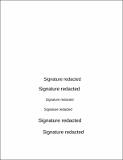Neural adaptive mechanisms in respiratory regulation : theory and experiments
Author(s)
Young, Daniel Laurence
DownloadFull printable version (13.13Mb)
Other Contributors
Massachusetts Institute of Technology. Dept. of Mechanical Engineering.
Advisor
Chi-Sang Poon.
Terms of use
Metadata
Show full item recordAbstract
The respiratory regulatory system is an example of a complex biological control system. The principle goal of the regulator is to preserve the chemical balance of 02, CO2 and pH in the body. Although much is known about the visceral aspects of the respiratory control system, such as lung anatomy, gas exchange, and the mechanics of breathing, considerably less is understood about the neural centers in the brainstem that give rise to known varied respiratory responses. A more complete understanding of respiratory regulation necessitates better knowledge of these underling brain mechanisms. While the task of breathing may seem straightforward, the respiratory system faces many challenges that threaten to perturb homeostasis. It has been shown that the respiratory system adapts itself to better meet changing conditions, for example to meet the stresses of high altitude or increased airway resistance. The question remains then: what neural processes in the brainstem controller participate to engender such sophisticated autonomic regulation? The primary aim of this thesis was to uncover and characterize the central adaptive mechanisms involved in modulating respiratory output. A series of in-vivo animal studies is presented that were designed to elucidate the organizational and functional principles of neural adaptation intrinsic to the respiratory control centers. In these open-loop experimental studies, afferent feedback from vagal slowly-adapting receptors and/or carotid chemoreceptors was electrically activated. (cont.) The dynamic respiratory control response was assessed by measuring the efferent activity of the phrenic nerve. Administration of pharmacological agents was used to determine the contribution of NMDA receptors to the observed responses. The roles of certain brainstem nuclei were assessed by electrical lesions. The experimental results revealed dynamic and temporal filtering properties produced by adaptation and phase-locked gating respectively in the respiratory controller. These responses demonstrated novel neural differential and integral computations specific to expiratory and inspiratory control circuits. Moreover, mechanical and chemical feedbacks were shown to adaptively modulate each other's neural transfer functions in an associative manner. Modeling and computational studies were used to assess the significance that these processes may have for stability and compensatory responses during certain physiologic states and diseases. It is suggested that these neural processes may participate in the adaptive optimal control of breathing.
Description
Thesis (Ph. D.)--Massachusetts Institute of Technology, Dept. of Mechanical Engineering, 2002. Includes bibliographical references (p. 195-215).
Date issued
2002Department
Massachusetts Institute of Technology. Department of Mechanical EngineeringPublisher
Massachusetts Institute of Technology
Keywords
Mechanical Engineering.